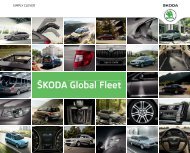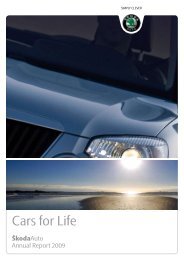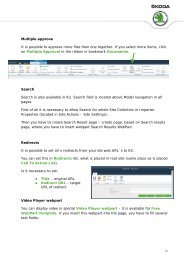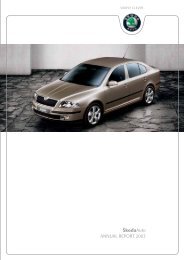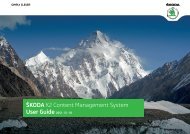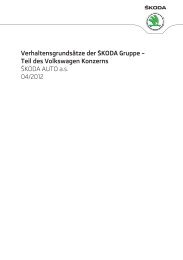Å kodaAuto ANNUAL REPORT 2006 - Skoda Auto
Å kodaAuto ANNUAL REPORT 2006 - Skoda Auto
Å kodaAuto ANNUAL REPORT 2006 - Skoda Auto
You also want an ePaper? Increase the reach of your titles
YUMPU automatically turns print PDFs into web optimized ePapers that Google loves.
Soil and Groundwater Protection,<br />
Water Management<br />
The Company has fully secured its<br />
operations to prevent environmental<br />
damage and is successfully cleaning up<br />
legacy damage caused by insensitive<br />
industrial production techniques used<br />
before the Company joined the<br />
Volkswagen Group.<br />
By the end of <strong>2006</strong>, over 80% of<br />
environmental damage requiring<br />
clean-up had been resolved at a cost of<br />
CZK 515 million. No accidents requiring<br />
clean-up work occurred in <strong>2006</strong>. During<br />
the year, the Company completed<br />
clean-up of legacy environmental burdens<br />
at the Kvasiny and Vrchlabí plants, and<br />
extensive clean-up work continued at the<br />
Mladá Boleslav plant to remove<br />
contaminated floors and underlying<br />
sediments in the older manufacturing<br />
halls and to lay new floors that do not<br />
allow hazardous materials to seep<br />
through into the soil. In the water<br />
management area, the Company built<br />
a back-up water supply system for the<br />
Kvasiny plant based on groundwater<br />
resources and secured new lots and<br />
car-parks to prevent any possible water<br />
contamination from petroleum-based<br />
products.<br />
One of the Company’s most fundamental<br />
tasks is to keep water consumption to the<br />
bare minimum and return water to the<br />
ecosystem while burdening the<br />
environment as little as possible. The<br />
success of the measures we have taken to<br />
fulfil this task are demonstrated by water<br />
consumption and wastewater discharge<br />
figures per vehicle produced, as well as by<br />
the fact that, thanks to newly implemented<br />
technologies, the purity of the wastewater<br />
we discharge is substantially higher than<br />
the prescribed limits.<br />
Waste Management<br />
A number of waste-reduction measures<br />
have been implemented in our<br />
development and production processes.<br />
Right from the development stages,<br />
vehicles are engineered to maximise the<br />
use of recyclable materials in production.<br />
With the aim of minimising negative<br />
impacts of waste on the environment, all<br />
waste is sorted and most of it is recycled.<br />
Of the total amount of waste generated in<br />
<strong>2006</strong>, only 12% ended up in landfills or<br />
incinerators. Most of the waste we<br />
produce, including metals, is put to<br />
further use. Such waste materials include<br />
glass, paper, waste oils, solvents, cables,<br />
toner cartridges, foundry sand, plastics,<br />
and plastic film. Special attention in this<br />
area is paid to recovering and reusing<br />
materials from non-returnable containers.<br />
The effectiveness of the measures taken<br />
can be documented by figures showing<br />
the amount of waste generated (not<br />
including metals) per vehicle produced.<br />
In 1997 this indicator was 84 kg/vehicle,<br />
while by <strong>2006</strong> it had fallen to 41 kg/vehicle.<br />
50









